Sacrificial Volume Materials for Small Hole Generation in Low-Temperature Cofired Ceramics
Abstract
:1. Introduction
1.1. Overview of Existing Methods
1.2. Requirements
- Ease of use, i.e., simple application and filling method for different hole shapes (or grooves or others);
- Potential for multi-hole filling with a diameter equal or larger than 127 µm on a 127 µm thick tape over a large surface (typically 50 mm × 50 mm here);
- Remain in place and retain its initial shape during lamination;
- Allow for a good quality lamination (adhesive assisted or not) with low lamination parameters;
- No negative effect on the tape or metal layers (coloration, dissolution, etc.);
- Burn off during firing at temperatures lower than 700 °C to leave no residue;
- Non-hazardous to health or environment;
- Low cost and widely available.
2. Materials and Methods
- HEC 2 wt%
- HEC 5 wt%
- agar-agar
- gelatin
- carbon paste from C12 [33]
- no SVM (reference)
2.1. Fabrication
2.2. After Firing Analysis
2.2.1. Visual Inspection and Dimensional Measurements
2.2.2. Thermal Gravimetric Analysis
2.2.3. Scanning Electron Microscopy with Energy-Dispersive X-ray (SEM-EDX) Analysis
3. Results
3.1. Visual Inspection after Stacking
3.2. Visual Inspection after Lamination
3.2.1. Hole and Pitch Size and Shrinkage after Firing
3.2.2. Lamination Evaluation
3.2.3. Thermogravimetric Analysis (TGA) Results
3.2.4. SEM-EDX Results
4. Discussion
5. Conclusions
Author Contributions
Funding
Acknowledgments
Conflicts of Interest
References
- Gyurk, W.J. Methods for Manufacturing Multilayered Ceramic Bodies. U.S. Patent 3,192,086, 29 June 1965. [Google Scholar]
- Nakayama, T. Low-Fire Green Ceramic Articles and Slip Compositions for Producing Same. U.S. Patent 4,010,133, 1 March 1977. [Google Scholar]
- Kumar, A.H.; McMillan, P.W.; Tummala, R.R. Glass-Ceramc Structures and Sintered Multilayer Substrates Thereof with Circuit Patterns of Gold, Silver or Copper. U.S. Patent 4,301,324, 17 November 1981. [Google Scholar]
- KOA LTCC Substrates. Available online: http://www.koaspeer.com/products/ltcc-substrates-others/ltcc-substrates/ (accessed on 28 September 2020).
- TDK. Vol.3 TDK’s LTCC AiP Technology Supports 5G Communications. Available online: https://www.tdk.com/tech-mag/front_line/003 (accessed on 28 September 2020).
- KYOCERA. Material Properties|Ceramic Packages|Products|KYOCERA. Available online: https://global.kyocera.com/prdct/semicon/material/ (accessed on 28 September 2020).
- DuPont. Low Temperature Co-Fired Ceramic Material Systems. Available online: https://www.dupont.com/electronic-materials/low-temperature-co-fire-ceramic-materials.html (accessed on 28 September 2020).
- Ferro Electronic Materials. Available online: https://www.ferro.com/products/product-category/electronic-materials (accessed on 28 September 2020).
- Lee, Y.C.; Kim, T.W.; Ariffin, A.B.; Myoung, N.-G. 60-GHz amplitude shift-keying receiver LTCC system-on-package module. Microw. Opt. Technol. Lett. 2011, 53, 758–761. [Google Scholar] [CrossRef]
- Fournier, Y. 3D Structuration Techniques of LTCC for Microsystems Applications. Ph.D. Thesis, Ecole Polytechnique Fédérale de Lausanne, Lausanne, Switzerland, 2010. [Google Scholar]
- Malecha, K.; Golonka, L.J. Three-dimensional structuration of zero-shrinkage LTCC ceramics for microfluidic applications. Microelectron. Reliab. 2009, 49, 585–591. [Google Scholar] [CrossRef]
- Arenas Buendia, C. Enhanced Fluid Characterization in the Millimeter-Wave Band Using Gap Waveguide Technology. Ph.D. Thesis, Universitat Politècnica de València, Valencia, Spain, 2016. [Google Scholar]
- Jones, W.K.; Yanqing, L.; Mingcong, G. Micro heat pipes in low temperature cofire ceramic (LTCC) substrates. IEEE Trans. Comp. Packag. Technol. 2003, 26, 110–115. [Google Scholar] [CrossRef]
- Shi, P.Z.; Chua, K.M.; Wong, S.C.K.; Tan, Y.M. Design and performance optimization of miniature heat pipes in LTCC. J. Phys. Conf. Ser. 2006, 34, 142–147. [Google Scholar] [CrossRef]
- Tlili, M.; Sinou, M.; Karnfelt, C.; Bourreau, D.; Peden, A. Micro Heat Pipe Design and Fabrication on LTCC. In Proceedings of the 2018 7th Electronic System-Integration Technology Conference (ESTC), Dresden, Germany, 18–21 September 2018; IEEE: Dresden, Germany, 2018; pp. 1–3. [Google Scholar]
- Malecha, K.; Jurków, D.; Golonka, L.J. Comparison of solvent and sacrificial volume-material-based lamination processes of low-temperature co-fired ceramics tapes. J. Micromech. Microeng. 2009, 19, 065022. [Google Scholar] [CrossRef]
- Malecha, K. Fabrication of cavities in low loss LTCC materials for microwave applications. J. Micromech. Microeng. 2012, 22, 125004. [Google Scholar] [CrossRef]
- Toskov, S.; Krcic, N.; Radosavljevic, G. LTCC lamination process using PMMA fugitive material. In Proceedings of the 2014 37th International Spring Seminar on Electronics Technology, Dresden, Germany, 7–11 May 2014; IEEE: Piscataway, NJ, USA, 2014; pp. 21–26. [Google Scholar]
- Peterson, K.A.; Patel, K.D.; Ho, C.K.; Rohde, S.B.; Nordquist, C.D.; Walker, C.A.; Wroblewski, B.D.; Okandan, M. Novel Microsystem Applications with New Techniques in Low-Temperature Co-Fired Ceramics. Int. J. Appl. Ceram. Technol. 2005, 2, 345–363. [Google Scholar] [CrossRef]
- Maeder, T.; Jacq, C.; Fournier, Y.; Hraiz, W.; Ryser, P. Structuration of zero-shrinkage LTCC using mineral sacrificial materials. In Proceedings of the 2009 European Microelectronics and Packaging Conference, Rimini, Italy, 16–18 June 2009; pp. 1–6. [Google Scholar]
- Tick, T.; Jäntti, J.; Henry, M.; Free, C.; Jantunen, H. LTCC integrated air-filled waveguides for G-band applications. Microw. Opt. Technol. Lett. 2009, 51, 176–178. [Google Scholar] [CrossRef]
- Lahti, M.; Kautio, K.; Karioja, P. Integrated LTCC Modules by Laminating and Co-firing Tapes Directly on Heat Sink. In Proceedings of the 2006 European Conference on Wireless Technologies, Manchester, UK, 10–12 September 2006; IEEE: Piscataway, NJ, USA, 2006; pp. 372–375. [Google Scholar]
- Horváth, E.; Harsányi, G. Optimization of fluidic microchannel manufacturing processes in low temperature co-fired ceramic substrates. Period. Polytech. Electr. Eng. 2010, 54, 79. [Google Scholar] [CrossRef] [Green Version]
- Hrovat, M.; Belavic, D.; Cilensek, J.; Drnovsek, S.; Holc, J.; Jerlah, M. Investigation of sacrificial layers for 3D LTCC structures and some preliminary results. In Proceedings of the 2009 32nd International Spring Seminar on Electronics Technology, Brno, Czech Republic, 13–17 May 2009; IEEE: Piscataway, NJ, USA, 2009; pp. 1–6. [Google Scholar]
- Birol, H.; Maeder, T.; Ryser, P. Application of graphite-based sacrificial layers for fabrication of LTCC (low temperature co-fired ceramic) membranes and micro-channels. J. Micromech. Microeng. 2007, 17, 50–60. [Google Scholar] [CrossRef]
- Malecha, K.; Maeder, T.; Jacq, C.; Ryser, P. Structuration of the low temperature co-fired ceramics (LTCC) using novel sacrificial graphite paste with PVA–propylene glycol–glycerol–water vehicle. Microelectron. Reliab. 2011, 51, 805–811. [Google Scholar] [CrossRef] [Green Version]
- Jurkow, D.; Roguszczak, H.; Golonka, L. Cold chemical lamination of ceramic green tapes. J. Eur. Ceram. Soc. 2009, 29, 703–709. [Google Scholar] [CrossRef]
- Smetana, W.; Balluch, B.; Stangl, G.; Lüftl, S.; Seidler, S. Processing procedures for the realization of fine structured channel arrays and bridging elements by LTCC-Technology. Microelectron. Reliab. 2009, 49, 592–599. [Google Scholar] [CrossRef]
- Khoong, L.E.; Tan, Y.M.; Lam, Y.C. Overview on fabrication of three-dimensional structures in multi-layer ceramic substrate. J. Eur. Ceram. Soc. 2010, 30, 1973–1987. [Google Scholar] [CrossRef]
- Schuler, K.; Venot, Y.; Wiesbeck, W. Innovative Material Modulation for Multilayer LTCC Antenna Design at 76.5 GHz in Radar and Communication Applications. In Proceedings of the 33rd European Microwave Conference, Munich, Germany, 7–9 October 2003; IEEE: Piscataway, NJ, USA, 2003; pp. 707–710. [Google Scholar]
- Ke, W.; Desiandes, D.; Cassivi, Y. The substrate integrated circuits—A new concept for high-frequency electronics and optoelectronics. In Proceedings of the 6th International Conference on Telecommunications in Modern Satellite, Cable and Broadcasting Service, Nis, Yugoslavia, 1–3 October 2003; TELSIKS 2003. IEEE: Piscataway, NJ, USA, 2003; Volume 1, pp. P-III–P-X. [Google Scholar]
- Tlili, M.; Kärnfelt, C.; Sinou, M.; Peden, A. Cold Chemical Lamination Tests of Grooved Internal Cavities in LTCC for Thermal Management. In Proceedings of the IMAPS From Nano to Macro Power Electronics and Packaging European Workshop, Tours, France, 28 November 2019; p. 6. [Google Scholar]
- Carbon Paste—C12 Advanced Technologies. Available online: http://c12materials.com/carbonpaste.html (accessed on 28 September 2020).
- Cellulose hydroxyéthylique MSDS—822068—Merck. Available online: https://www.merckmillipore.com/FR/fr/product/msds/MDA_CHEM-822068?ReferrerURL=https%3A%2F%2Fduckduckgo.com%2F (accessed on 16 October 2020).
- LTCC. Material System|A6M-E LTCC Tape-High Frequency Applications. Available online: https://www.ferro.com/products/product-category/electronic-materials/ltcc-material-systems/low-temperature-co-fired-_ltcc_--materials/a6m-e-ltcc-material-systems-for-high-frequency-applications (accessed on 6 October 2020).
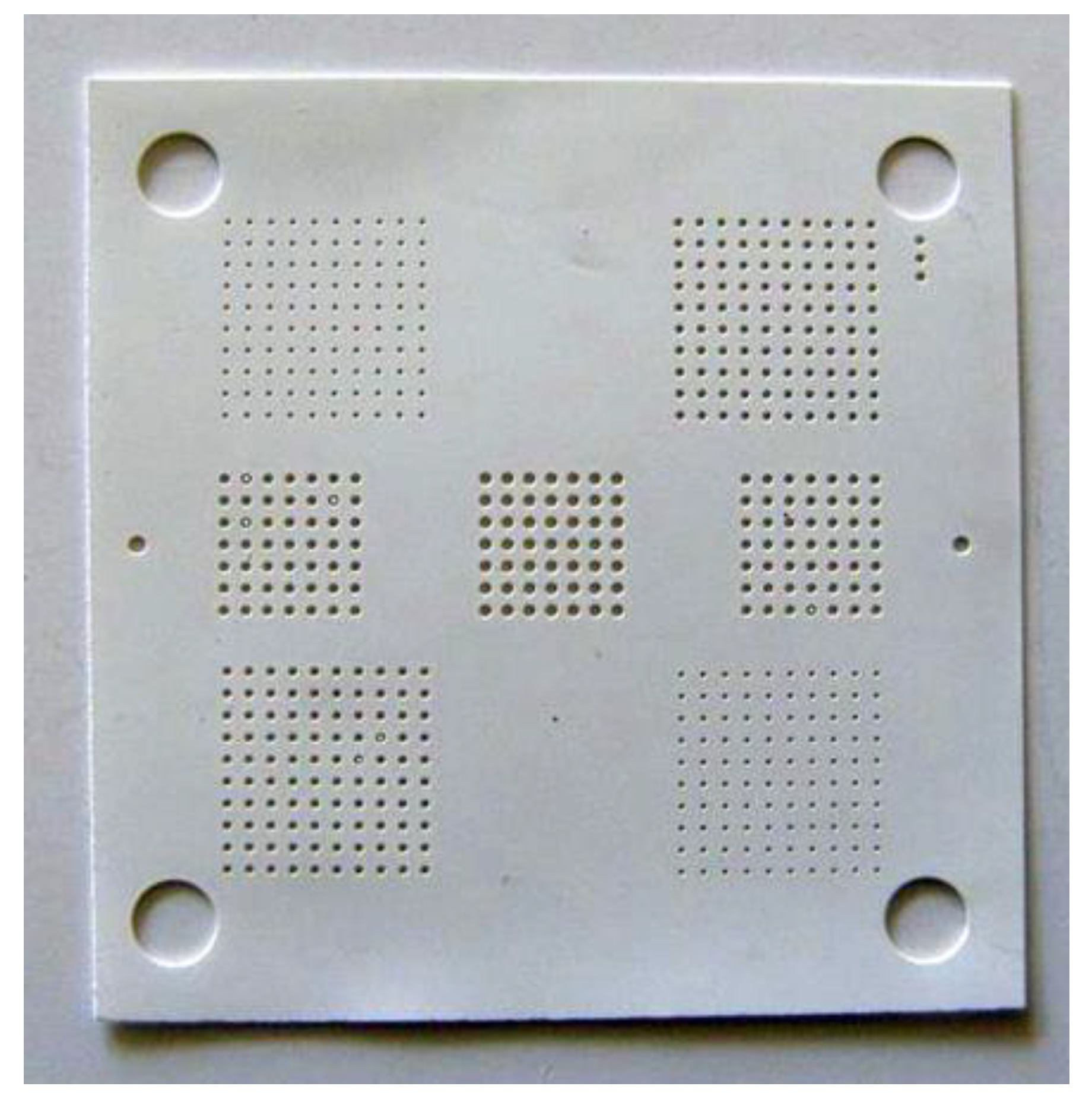
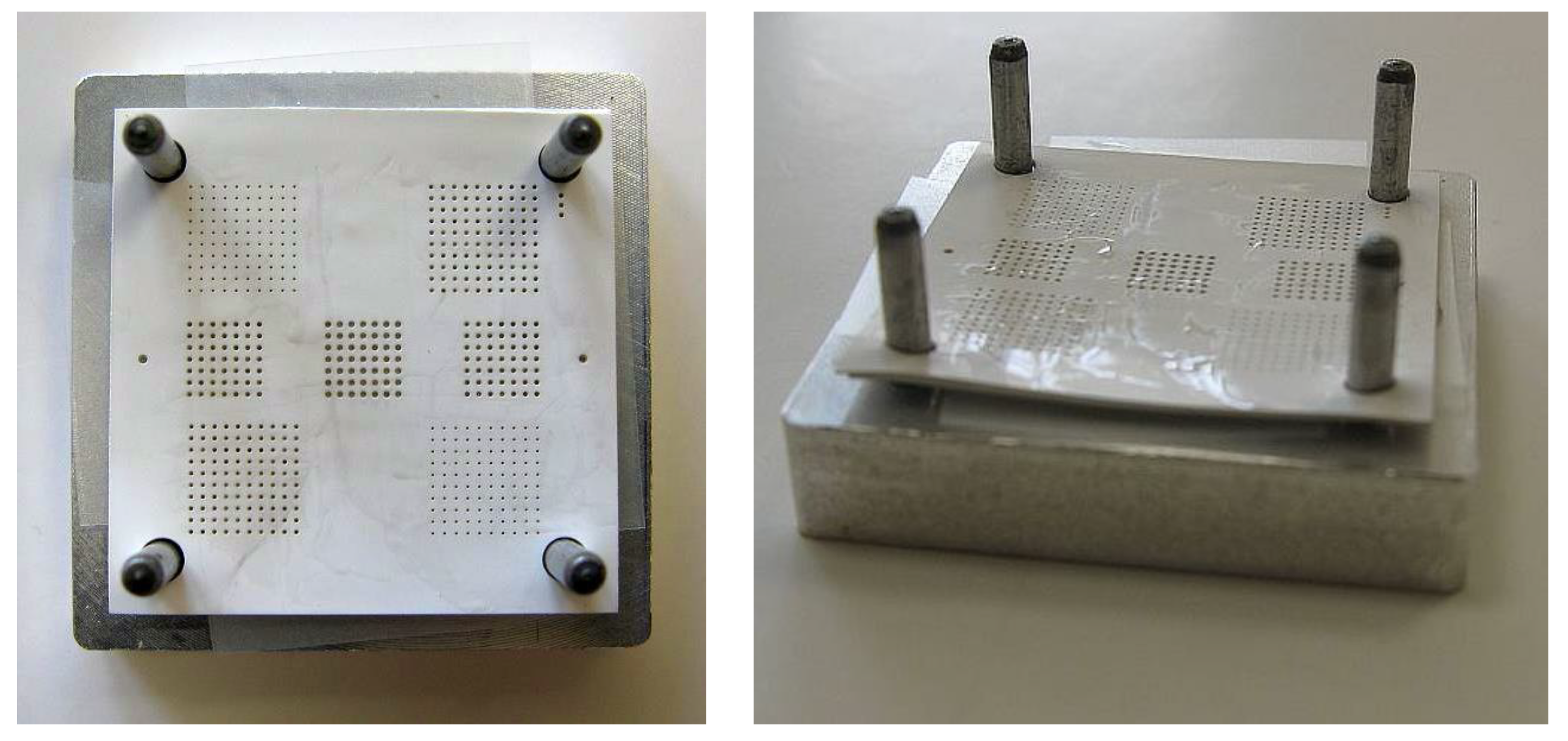

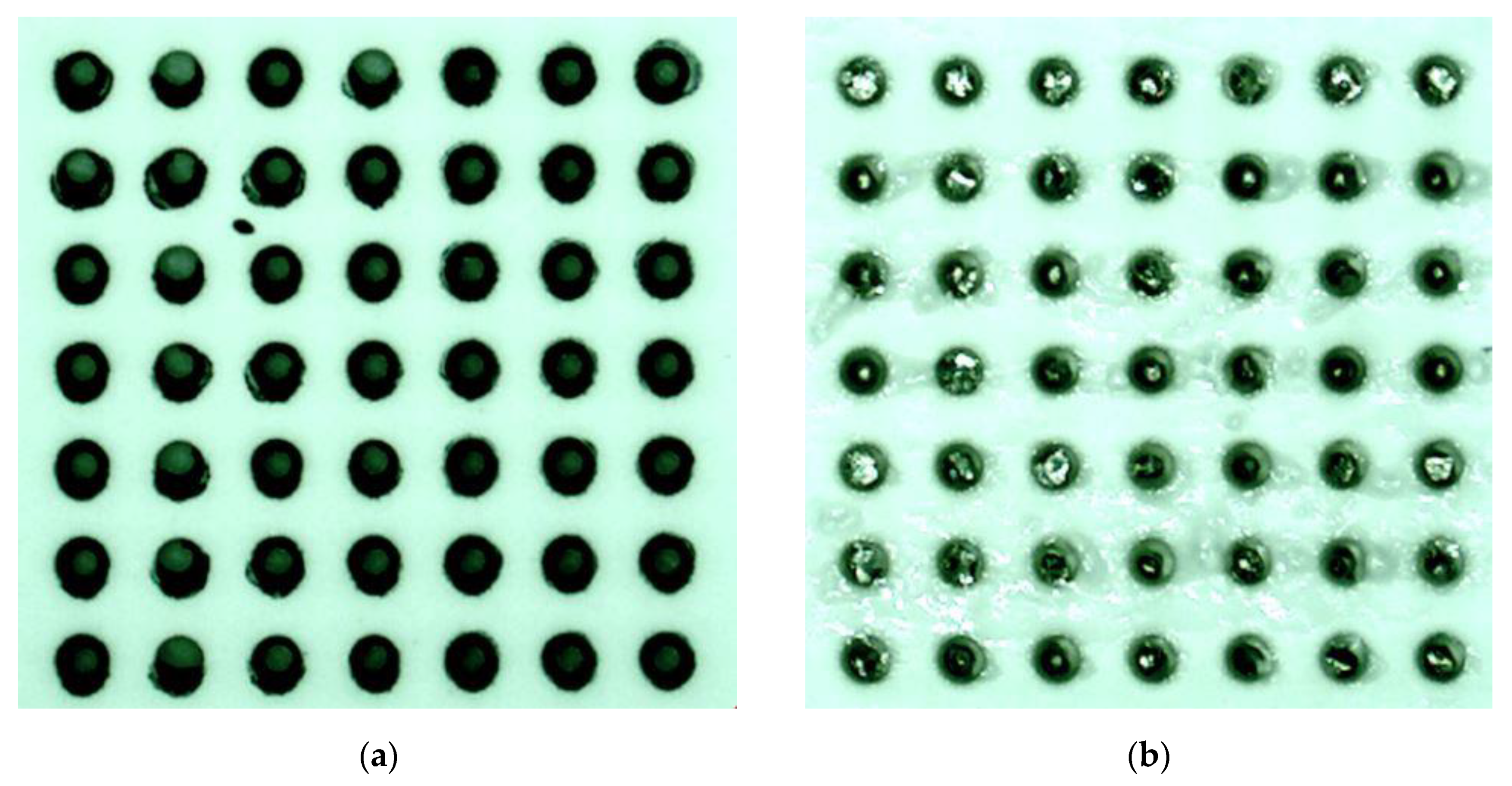

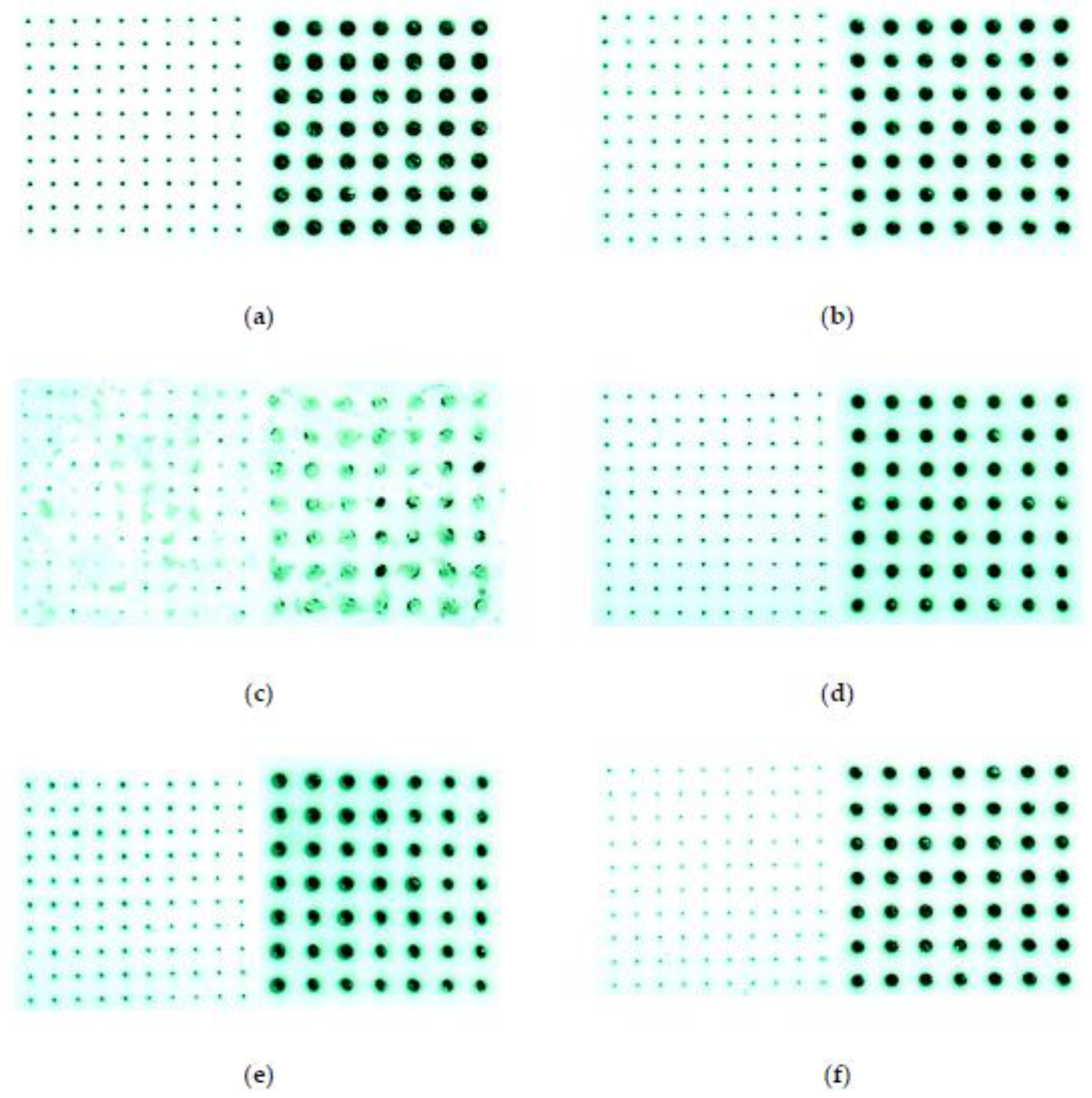


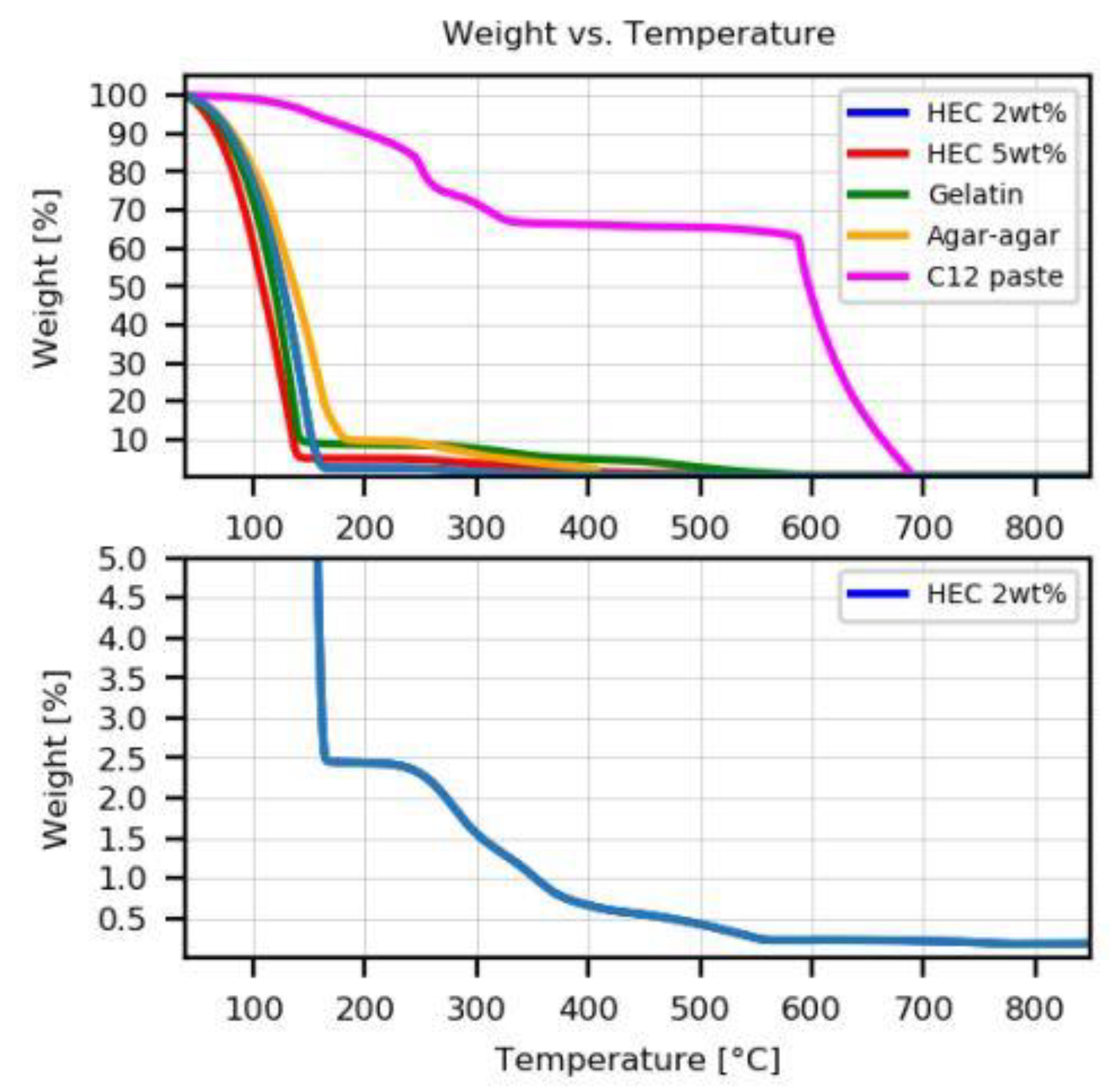

| Cut Size [µm] | HEC 2 wt% [µm]→[%] | HEC 5 wt% [µm]→[%] | Agar-Agar [µm]→[%] | Gelatin [µm]→[%] | Carbon Paste [µm]→[%] | No SVM [µm]→[%] |
|---|---|---|---|---|---|---|
| Ф 2 = 158 | 69 ± 3→56 1 | 72 ± 4→54 | - | 58 ± 14→63 | 74 ± 4→53 | 54 ± 12→66 |
| Ф 2 = 186 | 116 ± 2→37 | 111 ± 2→40 | - | 80 ± 14→57 | 110 ± 28→41 | 88 ± 5→53 |
| Ф 2 = 220 | 162 ±3→26 | 162 ± 6→26 | - | 128 ± 23→42 | 173 ± 7→21 | 136 ± 4→38 |
| Ф 2 = 268 | 204 ± 2→24 | 199 ± 6→26 | - | 179 ± 7→33 | 207 ± 6→23 | 174 ± 7→35 |
| Δ 3 = 573 | 451→21 | 451→21 | 452→21 | 454→21 | 461→20 | 462→19 |
| HEC 2 wt% | HEC 5 wt% | Agar-Agar | Gelatin | Carbon Paste | No SVM | |
|---|---|---|---|---|---|---|
| Measured thickness after firing | 277 µm | 274 µm | 80 µm/layer | 265 µm | 257 µm | 255 µm |
| Calculated z shrinkage | 27% | 28% | 37%/layer | 30% | 33% | 33% |
| HEC 2 wt% | HEC 5 wt% | Agar-Agar | Gelatin | Carbon Paste | |
|---|---|---|---|---|---|
| Liquid content [%] | 97.59 | 94.98 | 90.36 | 91.37 | 6.83 |
| Bulk decomposition temperature [°C] | 249 | 240 | 244 | 283 | 590 |
| Remaining weight at 62 °C [%] | 96.34 | 93.29 | 96.75 | 95.59 | 99.87 |
| HEC 2 wt% | HEC 5 wt% | Agar-Agar | Gelatin | Carbon Paste | No SVM | |
|---|---|---|---|---|---|---|
| Ease of use | Excellent | Excellent | Excellent | Excellent | No—requires screen-printing | Excellent |
| Filling of multiple holes over a large area | Excellent | Excellent | Excellent | Excellent | Poor for larger holes | NA |
| Keeps its shape during lamination | Yes, ±2–3 µm variation and 24–56% shrinkage | Yes, ±2–6 µm variation and 26–54% shrinkage | Not evaluated | No, ±7–23 µm variation and 33–63% shrinkage | No, ±4–28 µm variation and 23–53% shrinkage | No, ±4–12 µm variation and 35–66% shrinkage |
| Lamination quality | Excellent | Excellent | No lamination | Excellent | Excellent unless for “Landing pads” that inhibits lamination | Excellent |
| Negative effects | No | No | Yes, bursts during firing result in a rough substrate surface | No | Yes, coloring around hole orifices | No |
| Residues after firing | No | No | No, but ceramic outbursts in holes and on a top surface | No, but ceramic outbursts in few holes | No | NA |
| Hazardous to health or environment | No | No | No, eatable | No, eatable | Yes | NA |
| Price 1 and availability | 25 €/100 gr | 25 €/100 gr | ~23 €/500 gr | ~2 €/100 gr | 545 $/50 gr | 0 € |
Publisher’s Note: MDPI stays neutral with regard to jurisdictional claims in published maps and institutional affiliations. |
© 2020 by the authors. Licensee MDPI, Basel, Switzerland. This article is an open access article distributed under the terms and conditions of the Creative Commons Attribution (CC BY) license (http://creativecommons.org/licenses/by/4.0/).
Share and Cite
Kärnfelt, C.; Zelenchuk, D.; Sinou, M.; Gallée, F.; Douglas, P. Sacrificial Volume Materials for Small Hole Generation in Low-Temperature Cofired Ceramics. Electronics 2020, 9, 2168. https://doi.org/10.3390/electronics9122168
Kärnfelt C, Zelenchuk D, Sinou M, Gallée F, Douglas P. Sacrificial Volume Materials for Small Hole Generation in Low-Temperature Cofired Ceramics. Electronics. 2020; 9(12):2168. https://doi.org/10.3390/electronics9122168
Chicago/Turabian StyleKärnfelt, Camilla, Dmitry Zelenchuk, Maïna Sinou, François Gallée, and Paula Douglas. 2020. "Sacrificial Volume Materials for Small Hole Generation in Low-Temperature Cofired Ceramics" Electronics 9, no. 12: 2168. https://doi.org/10.3390/electronics9122168





